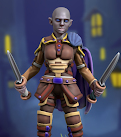Dwarves of Davric, escapees from subterranean seas
Dwarves, escapees from subterranean seas
Traditions: Divine, Martial
Dwarves are a costal and mountain people their legends tell
of sailing starless seas in the Middle and Lower Deeps, and of their battles
against the monsters of the Deeps. Those days are long lost, echoes of before
the Retreat.
The dwarves lost.
Their warriors fought fighting withdrawal, their ships fighting on the underground
seas, their armies holding back the hordes to give their citizens time to flee
higher and higher in the deeps. Thousands
were slaughtered, entire clans lost, their names honored.
Other clans had their names stricken, wiped from the rolls
of honor. Some clans were lost to the
forces rising up from the lower deeps, turning their backs on their brethren.
These forsaken clans were left to suffer for their betrayal.
When the dwarves broke through to the surface, they emerged
in the mountains on the coast of the central sea. They set up new cities in the mountains and
expanded to the coasts. When the empire first came the conflicts were brief,
but many of the dwarves welcomed imperial citizenship.
Dwarves of today:
The modern dwarves are still based on clans. They also retain their system of familial
guilds and caste systems. The Caste
system is still in place, but dwarves do recognize talent, a baker’s son with a
talent for sailing can become a member of the warrior caste, or a dwarf with
sorcerous talent may earn a place in the small arcane caste.
Dwarves still practice worship of their elemental gods, as
well as ancestor worship. Their priests
are also the keepers of history and maintain records of bloodlines and
legacies. The priest, or basalt, caste is the highest caste in dwarven society,
though ‘priest’ is a generalization; Bards, Clerics, Inquisitors and even some
Shamans make up the priest caste, as well as adapts and experts.
The granite caste is the next highest. While the dwarven
mithral clad ships are all but gone, the dwarves maintain formidable infantry
and naval forces. Combat prowess is important in dwarven society and the warriors
are highly regarded. The line between the infantry and the sailors is
blurred. The infantry serve on the ships
in rotation, and the navy shares with the troops on rotation the profits from
their attacks on pirates and slavers. One
legacy from their days living underground is the dwarves have never developed a
cavalry tradition.
Almost as respected as the warrior caste is the mining caste.
The steel caste delve back into the middle deeps searching for veins of mithral
and the rare metals used to make adamantine.
There is ongoing friction in that the miners end up fighting with dokk
alfar, duergar and other threats that dwell in the deeps, but aren’t considered
warriors with the benefits of the caste.
Next is the gold caste.
This caste consists merchants and skilled craftsmen. Dwarven alchemists are also part of this caste. They are, in general, the most travelled of
the dwarves and most likely to have questions about the structure of dwarven
society.
Below them is the remainder of dwarven society. The commoners, unskilled labor, and everyone
else. This broad caste is the called the
halite caste, sometimes referred to by outsiders as the salt of the earth.
Relations with others.
Dwarves consider any non-dwarves as out-caste, outside the
caste system. Generally the relationship
between dwarves and non-dwarves result in the non-dwarf being seen as being a
lower caste than their social position allows.
Diplomacy of course overrides convention. No priest is going to tell the Patriarch of the
Church of the Hermit he is lesser than an acolyte!

Comments
Post a Comment